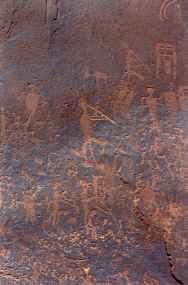
 |
One of the best known rock art panels is Newspaper Rock, located in the Needles district of Canyonlands National Park. This rock panel, located a few feet from the road contains an abundance of rock art, mostly Anasazi, but including more recent additions as shown by the horse and rider (the horse was introduced to the New World by the Spanish after the Anasazi had vanished). |
| Much less common than the standard Anasazi rock art, the archaic period (500 BC and earlier) petroglyphs have a ghostly or otherworldly feel to them. Characteristic of these drawing, the figures are tall, tapered creatures without feet, often without arms. The best examples are difficult to reach. The example on the right is accessible by driving about 30 miles of dirt road (passable by passenger cars), followed by a 4.5 mile hike deep into a canyon. |  |
My favorite petroglyph of all is much less accessible. It is reachable by 30 miles of dirt road, followed by 20 miles of extremely rough 4-wheel drive road, followed by several miles of desert hiking down into a canyon. I have visited this place twice and never seen another person. The picture on the left below shows the entire panel, while the picture on the right shows a close-up of part of it.
 |
 |
 |
One time I drove up a 4WD "road" in a canyon and camped not too far from another family. That night it rained fairly hard and the "road" was now the river, about mid-thigh deep. The other family had a Toyota 4Runner and a Jeep with large tires for extra clearance. We all piled into the Jeep and went exploring. They had heard from a friend of a set of "7 faces" in a small side canyon, off a nearby canyon. The faces were supposed to be behind some heavy brush on an overhung wall. |
| After a bit of exploring we found the scene shown on the left. The next day, the father & I hiked up another canyon to find a moderately famous petroglyph and on the way we found the 4 faces shown on the right. I am sorry to say that when I returned several years later, the area had been "discovered", and it was now necessary to get one of a limited number of backcountry passes to even enter these canyons. |  |
 |
Along another dirt road I found the rather unique petroglyphs shown here. The one on the left shows a strange creature with a tapered triangle shaped body and long "antenna" sprouting from the head. The one on the right is what looks like a bird. |
| These two are unique in that rather than the conventional "scraping" into the rock, they consist of pecked holes, rather like Seurat's pointilism! The bottom picture is a series of more standard Anasazi petroglyphs found in the same general area. |  |

These two pictures were taken in a rest area / campground just off a heavily used road in the four corners area. The most famous petroglyph figure in the Southwest is Kokopelli, the flute player. One example of Kokopelli is just visible on the right of the picture to the right.
 |
 |
Two other miscellaneous petroglyphs are shown here. The one on the right is actually an Anasazi pictograph (white) drawn over a much older archaic drawing (barely visible in dark red).
 |
 |
| No discussion of rock art would be complete without a discussion of the famous flute player, Kokopelli. According to most common traditions, Kokopelli was a wandering minstrel type figure (or a series of them), also representing a fertility figure. In contrast, Hopi legend suggests that this Kokpelli is simply the sign of the Flute Clan, and indicates their wanderering prior to settling at the Hopi Mesas in Arizona. Whatever the truth may be, Kokopelli is found abundantly throughout the 4 corners region, and as far north as the Utah/Wyoming border. The picture at the right, containing 4 Kokopellis is just one of the numerous examples of Kokopelli to be found in the region. |

|